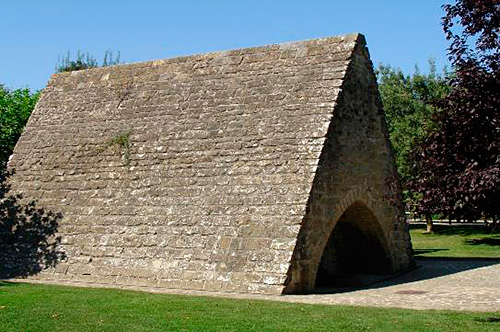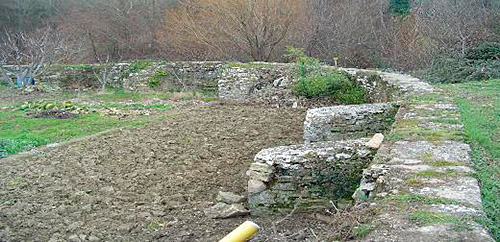16 October
Global Seminars & Invited Speaker Series
HYDRAULIC HERITAGE IN NAVARRA
Hydraulic types and uses in Navarre during the Middle Ages. average
David Alegria
Ph.D. in History
Navarre is, and according to the data we have, was rich in water during the Age average. Except occasionally in some regions, it had an abundance of rainfall B. In addition to the abundance of rivers, streams and ravines, there were aquifers and springs, as well as some endorheic lagoons that we know were also exploited during the Middle Ages. This generous presence of water undoubtedly contributed to the diversification and development of the hydraulic exploitations that took place quotation in the old medieval kingdom.
During the XII-XIV centuries we know several types and hydraulic uses in Navarre. This is the time of the urban boom in the kingdom of Navarre. The Way of St. James led to a great urban, social, economic and institutional development development . These were years of take-off, of adventure, of an expansion that facilitated the installation of hydraulic resources in the towns of Navarre. It is also the time of the beginning of the colonization of rivers and the humanization of the fluvial spaces. However, this period of prosperity was broken in the middle of the 19th century with the onset of the demographic and economic crisis caused by the Black Death. The epidemic and certain episodes of war at the time decimated the population and resources. Many hydraulic endowments were abandoned or reconverted. From the beginning of the 14th century, there were already signs of the crisis. One of them, the increase of the so-called "adverse climatology" with a succession of episodes of heavy rains, floods, frosts and droughts that hindered any recovery.
This is the context in which the different uses and types of hydraulics recorded flourish and evolve. In the medieval centuries, two significant facts also converge: on the one hand, the hydraulic forms detected are heirs of a late Roman bequest , especially rich in terms of facilities related to the supply of drinking water, water disposal, irrigation and bath culture; and, on the other hand, this baggage is joined by a melting pot of forms, techniques and currents of the hand of master builders of Muslim, Jewish and Frankish origin.
Taking into account the employment and purpose of the liquid element, a division of Navarre's medieval hydraulic resources into three large groups in the form of "economic sectors" is proposed:
Water supply and disposal. This group includes all those elements that allow the supply of 'drinking water' for both people and livestock. Also 'irrigation water'. It is water for basic needs; for consumption and for agricultural and livestock uses. This is fulfilled by a whole range of facilities, from dams and weirs to cisterns, canals, pipes, drains, fountains and wells, through waterwheels, irrigation ditches, ditches, sluices, sluice gates and tajaderas. The ice wells and ice wells documented in Navarre correspond strictly to modern times. It is worth mentioning the model of source outside the walls with a gabled roof, protected by thick walls that would preserve the quality and freshness of the water. The proliferation of wells in the city of Pamplona is also noteworthy, to the detriment of other possible water supply systems, basically due to the shallowness of its water table. A beautiful example of hydraulic engineering can be found in the solution adopted in the church of San Saturnino de Artajona by means of a stone column that led the rainwater from the roof of the temple in the form of a dragon's back to a cistern.

source medieval in Tajonar. Photo: David Alegría.
2. Motive water. This would be the water used to move machinery. The cases pointed out in Navarre are flour mills, rag mills and forges. The application of hydraulic energy in the medieval centuries would constitute a substantial technical advance with respect to the techniques used in previous centuries, which were more dependent on human and animal power. Water power contributed to the mechanization of milling. Hydraulic bellows (barquines) significantly increased the production and yield of the forges. The increase in population undoubtedly welcomed these innovations. It is striking that there are no records of hydraulic sawmills, especially given the abundance of wood in the mountains of Navarre and its traditional exploitation since ancient times. The so-called "Pyrenean almadías" are already documented between the 13th and 14th centuries. The dams in Sangües have a singular element called an 'arcal' as a 'sangradera' or 'portillo' to facilitate the transit of the wood. They consist of both vertical and horizontal wheel mills. The mills of the Ebro bridge in Tudela enjoy a wide ownership and a paradigmatic joint exploitation. The bucket mill model is registered in the northern regions, where the low water level and the lower cereal production were taken advantage of to the maximum. We also have some precise data of the level of production. A modest example of a flour mill ground about 30 kilos per day. The employment of the winch to raise the flour millstones instead of the davit denotes a certain archaism in terms of internal machinery. For their part, fulling mills are documented early, at the beginning of the 13th century.

Ibero Ironworks in Leitza (XIV-XIX centuries). Photo: David Alegría.
3. Service water. In this case, the liquid element acts for the transformation of raw materials or in relation to various utilities. Here we would include all the textile activity generated in dyeing and tanneries (tanneries), which require a constant supply of water as well as the most orderly possible disposal of wastewater. An effective employment of water is also recorded in threshing ponds, flax and hemp ponds, salt works and fisheries. These may have variants of the subject 'sarayas' or pesqueras (fish farms) and nasas (nets). The public bathhouses, private baths, lavatories and washing places, as well as the employment of thermal springs deserve a separate chapter. Water is present in some way in the medieval bridges and river walls with the difficulty of dating them with certainty in view of the continuous repairs and even imitations of styles that they suffered. Finally, boats, pontoons and hydraulic infrastructures are known as river ports (almezcares) of interest.

Defense walls in the Ezpeleta area in Huarte (XIV century). Photo: David Alegría.
The variety of hydraulic uses and types documented in Navarre during the Age average is remarkable. The water installations and their repercussions partner-economic and cultural stand out in the Age average, fundamentally with the extension of the irrigation spaces and the proliferation of "technified" ingenuities thanks to the water. In a way, they appear as the prelude to the industrial pre-revolution. This wide range of hydraulic uses and implications would allow water to play a fundamental role in the configuration of cultural heritage. Water generated "fluvial landscapes" and "hydraulic patterns" as an integral part of the heritage. Bridges or fountains, for example, would become landmarks. They are icons, the preferred image and cover letter of a locality; in final, a sign of heritage identity.
